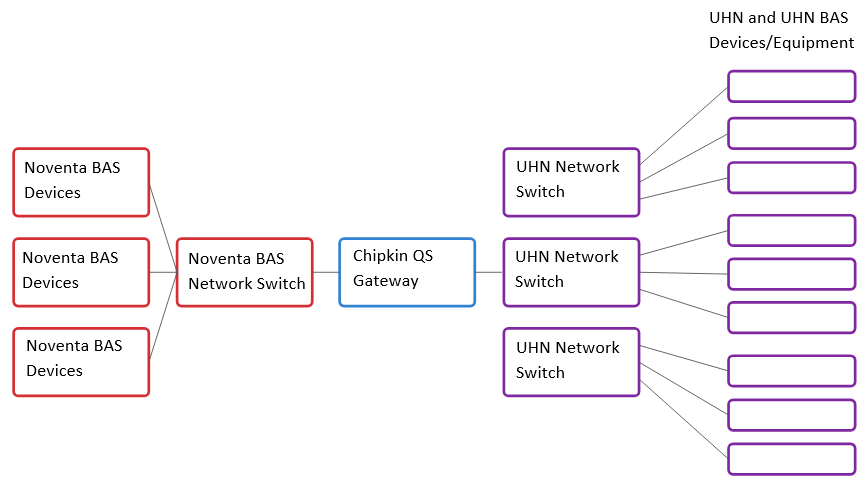Bridging BACnet IP Networks for Energy Efficiency and Control in a Hospital
 Click here to view the Case
Study.
Please CONTACT
US if you have any questions
Click here to view the Case
Study.
Please CONTACT
US if you have any questions
Project Overview:
BACnet IP BAS and Vlan Integration
Trane Technologies hired Chipkin to help their Client, an Energy Provider, interface with a Hospital's BACnet IP Building Automation Systems (BAS) and Vlan Network while limiting Read/Write capabilities. The end client initiative aimed to seamlessly connect the two BACnet/IP networks and then allow for precise limited control over chillers for energy distribution. Belimo Energy Valve Model number EV..R3+BAC (Version 4, DN 15...50) needed to be integrated into Trane Noventa front end (Tracer SC+) and University Health Network's (UHN) front end (JENEsys) BAS and Vlan BACnet IP Networks.
The unique aspect of this project lay in the end-client's following requirement:

- 1. To interface with the hospital's BAS and vLAN in a way where they could pick up the BACnet/IP points that the hospital provided without being able to discover other points.
- 2. To provide the Hospital with specific BACnet points, such as general temperatures, some alarms, etc., while exercising control over the hospital's capabilities to monitor (read-only) and control (read/write) of their device's Points.
- 3. To require both Client (UHN BAS) and Server (Noventa BAS) on the same Adapter (N1) and a different client (Noventa BAS) and server (UHN BAS) on the other Adapter (N2).
Below is a network diagram of the required system.

Solution approach: Testing the Dual Ethernet QuickServer Gateway
To complete the integration, the Client needed the QuickServer device to concurrently establish a BACnet Server and BACnet Client on both Ethernet Port 1 (N1) and Ethernet Port 2 (N2), something that is not common practice and that may not be feasible.
Above that, the QuickServer also needed to be able to receive 5,000 to 6,000 points from up to 150 BACnet IP devices from the Hospital's BAS and send 1,000 points from 10 devices from the Client's BAS. The QuickServer also needed to have separate ethernet ports so that the data collection could occur through the Chipkin device interface.
Chipkin recommended testing a single Dual Port FieldServer QuickServer gateway to see if the integration could be achieved with one device and custom configuration services as a solution to complete the integration.
After collecting the appropriate configuration data and creating the configuration file, Chipkin attempted to set up both the Client and Server on the same Adapter (N1). While Chipkin successfully was able to ready-read the data, this initial test configuration failed to transmit data. This led to uncertainty regarding the feasibility of having a client and server on the same node since in normal operations, the QuickServer is set to create a BACnet Server on one port (Eth1) and a BACnet Client on the other port (Eth2) simultaneously.
Subsequent testing with the client also revealed that both their front ends, Tracer SC+ and UHN front end (JENEsys), were unable to detect the server as a BACnet device. Not only that, but a final challenge emerged because of the high volume of data points being transmitted, leading to latency issues and a noticeable lag in system performance beyond the client's required operations.
The obvious solution to solve these challenges was for the client to procure an additional dual-port QuickServer Gateway, facilitating outbound data transmission and separating data reception. This solution involved eliminating the Adapter function from the server-side node and transforming it into a passive node. On top of that, Chipkin needed to specify UDP ports for communication with other BACnet Client devices. Finally, to resolve the discovery issue, static IP addresses for both Eth1 and Eth2 would be set as per the customer's specifications.
But, through extensive troubleshooting, Chipkin discovered a way that a single Dual Port QuickServer could be used to both read and serve on the same adapter for both Eth1 and Eth2. Then, to tackle the latency problem, a test on a single node demonstrated that reducing the number of points effectively eliminated system lag. Working closely with the client, Chipkin was able to remove unnecessary data points which improved the lag to the customer's satisfaction.
As expected, the scale of this extensive project demanded significant man-hours of support and a deep knowledge of systems integration and the capabilities of QuickServer Gateways. Chipkin was able to successfully complete the project.
Conclusions: Project Success
Chipkin conveyed the above conclusion to the clients and thus reached a successful completion of this project and earned a happy client!
As a comment, the client provided Chipkin with the following kind words:
Bobby K.:
"Much appreciated. We are checking on the live system and it looks good so far!"Brian J.:
"Awesome, thank you very much for all your help, Jane! Really appreciate it."Matthew H.:
"Thank you very much! We really appreciate all your hard work!
Thanks again!"Trane Technologies
About Us
Chipkin™ is a building and industrial automation protocol expert. We develop, configure, install, and support gateways (protocol converters), data loggers and remote monitoring and control applications.